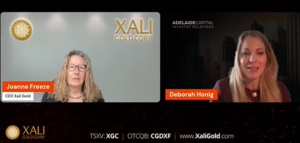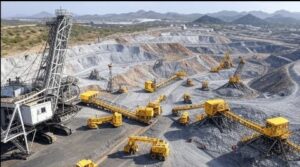VANCOUVER, Canada, March 22, 2021 – Sonoro Gold Corp. (TSXV: SGO | OTCQB: SMOFF | FRA: 23SP) (“Sonoro” or the “Company”) is pleased to report assay results from its continuing drill program at the Company’s Cerro Caliche gold project in Sonora, Mexico. The new results reflect 20 RC drill holes, totaling 1,792 meters, from Buena Suerte and the adjacent Japoneses gold mineralized zones and highlight the following:
- Spacing between the Buena Suerte and Japoneses zones has been reduced to approximately 100 meters in the northern extensions indicating the zones may merge with further infill drilling.
- Drill holes SCR-201, SCR-203, SCR-205 and SCR-207 at the 200-meter, high-grade north extension of Buena Suerte all cut high-grade intercepts.
- Drilling at the southwest extension of Buena Suerte identifies a 100-meter-long high-grade splay vein zone and widens the Buena Suerte zone toward the west.
- High-grade zone identified at the northwest extension of Japoneses, approximately 150 meters east of the 200-meter-long high-grade zone at Buena Suerte.
The map below shows the location of the 20 RC drill holes as well as the proximity between the Buena Suerte and Japoneses gold mineralized zones.
The image below illustrates a 1-kilometer cross section of the concession’s Central Zone.
Additional Longitudinal and Cross Sections can be found on the Cerro Caliche project page of the Company’s website.
Buena Suerte Gold Mineralization Zone
On the southwest flank of the recently extended Buena Suerte zone, a new 100-meter-long high-grade vein, or splay, was identified with drill hole SCR-219 which intercepted 1.5 meters averaging 6.475 g/t Au within a larger interval of 16.76 meters averaging 1.427 g/t Au. Drill hole SCR-158, located 100 meters northwest of SCR-219, earlier reported a 6.10-meter intercept averaging 0.7 g/t Au, including 3.05 meters averaging 1.34 g/t Au. The northwest trending splay is located midway between the Buena Suerte vein and the El Quince vein 200 meters further west.
On the eastern flank of the Buena Suerte zone, drill hole SCR-201 intercepted 9.14 meters averaging 0.74 g/t Au. Within the zone’s main vein, drill hole SCR-209 intercepted 4.57 meters averaging 0.77 g/t Au and, 70 meters to the southeast, drill hole SRC-211 intercepted 3.05 meters averaging 4.766 g/t Au.
Highlights from Buena Suerte are as follows:
- SCR-201 intercepted 14 m averaging 0.74 g/t Au; including 1.52 m averaging 2.096 g/t Au
- SCR-203 intercepted 09 m averaging 0.712 g/t Au; including 1.53 m averaging 2.04 g/t Au
- SCR-205 intercepted 14 m averaging 0.593 g/t Au; including 1.53 m averaging 1.528 g/t Au
- SCR-207 intercepted 05 m averaging 0.621 g/t Au; and 1.52 m averaging 1.292 g/t Au
- SCR-209 intercepted 57 m averaging 0.770 g/t Au; including 1.53 m averaging 1.786 g/t Au
- SCR-211 intercepted 05 m averaging 4.766 g/t Au
- SCR-219 intercepted 16.76 m averaging 1.427 g/t Au; including 1.52 m averaging 6.475 g/t Au
The image below illustrates a 900-meter longitudinal section of drill holes at Buena Suerte.
Japoneses Gold Mineralization Zone
On the western flank of the Japoneses gold mineralized zone, directly adjacent to the eastern flank of the Buena Suerte gold mineralized zone, the distance between the two zones was reduced to approximately 100 meters with drill hole SCR-218 intercepting 22.86 meters averaging 0.505 g/t Au and drill hole SCR‑220 intercepting 22.86 meters averaging 0.505 g/t Au. Future drilling within this area will continue to investigate surface exposures which include epithermal quartz veins in the highly silicified outcropping rock consisting of quartzite and rhyolitic intrusive.
Drilling results from the west-central flank of the Japoneses zone outline additional mineralized material with drill hole SCR-204 which intercepted 10.67 meters averaging 1.355 g/t Au, including 1.53 meters averaging 6.329 g/t Au. In the southern portion of Japoneses, infill drilling cut multiple veins, demonstrating an extensive shallow oxide gold mineralization with drill hole SCR-214 intercepting 18.29 meters averaging 0.577 g/t Au and drill hole SCR-215 intercepting 12.2 meters averaging 0.517 g/t Au.
Highlights from Japoneses are as follows:
- SCR-204 intercepted 10.67 m averaging 1.355 g/t Au; including 53 m averaging 6.329 g/t Au
- SCR-214 intercepted 18.29 m averaging 0.577 g/t Au; including 1.52 m averaging 1.972 g/t Au
- SCR-215 intercepted 12.20 m averaging 0.517 g/t Au
- SCR-218 intercepted 22.86 m averaging 0.505 g/t Au; including 1.52 m averaging 1.952 g/t Au
- SCR-220 intercepted 22.86 m averaging 0.534 g/t Au; including 1.53 averaging 1.843 g/t Au
Kenneth MacLeod, President and CEO of Sonoro, stated, “With over 44,500 meters of drilling completed on Cerro Caliche to date, we are pleased to open the data room to geological and mining consultants, Micon International, for preparation of an updated NI 43-101 resource report. Additional assays for drilling to the end of March will be provided to Micon by mid-April for inclusion in the resource report, which is anticipated to be completed in mid-2021.”
John Darch, Chairman of Sonoro, added that “The results continue to build a case for a substantial increase in our upcoming NI 43-101 resource update, as both zones look increasingly likely to coalesce into a single body of shallow, oxide gold mineralization which may justify a single larger pit. At the same time, the discovery of a high-grade gold vein near the Buena Suerte’s southwestern extent not only adds to the project’s resource potential, but it also illustrates the project’s potential for high-grade gold veins.”
Assay Results from Buena Suerte and Japoneses Gold Mineralized Zones
All reported intervals in this news release are from 45-degree inclined drill holes cutting an assumed 70 to 80 degree dipping vein zone toward the drill hole. Therefore, the intercept is considered to be approximately 30 degrees or less from having a perpendicular intersection. True widths of the reported drill widths are anticipated to be about 80 percent or more of intercept widths reported.
Drill collar locations, azimuths and dips for the drill holes included are provided in the table below.
Quality Assurance/Quality Control (“QA/QC”) Measures and Analytical Procedures
Drill samples are collected with an airstream cyclone and passed into a splitter that divides each sample into quarters. The quartered samples are then bagged and sealed with identification. The sample group has blanks, standards and duplicates inserted into the sample stream.
Bureau Veritas (BV) collects from the drill site the samples and transports them directly to the preparation laboratory in Hermosillo, Sonora. At the prep. laboratory, a split part of each sample (about 500 grams) is reduced through crushing, splitting and pulverization. Thirty grams of each pulverized sample is split apart in the Hermosillo laboratory and undergoes a “Fire Assay” for gold content by reducing the fire assay to a concentrated button of material that is dissolved in acids and the gold content determined by atomic absorption. About another 200 grams of each sample are sent by BV to their Vancouver, Canada laboratory and dissolved there in aqua regia for multi-element ICP analysis, including silver.
No QA/QC issues were noted with the results received from the laboratory.
Geologic Description
Cerro Caliche is located 45 kilometers east southeast of Magdalena de Kino in the Cucurpe-Sonora Mega-district of Sonora, Mexico. Multiple historic underground mines were developed in the concession including Cabeza Blanca, Los Cuervos, Japoneses, Las Abejas, Boluditos, El Colorado, Veta de Oro and Espanola. Mineralization types of the Cucurpe-Sonora Mega-district include variants of epithermal low sulfidation veins and related mineralized dikes and associated volcanic domes. Local altered and mineralized felsic dikes cut the mineralized meta-sedimentary rock units and may be associated with mineralization both in the dikes and meta-sedimentary rocks.
Qualified Person Statement
Stephen Kenwood, P.Geo., a Director of Sonoro, is a Qualified Person within the context of National Instrument 43-101 (NI 43-101) and has read and approved this news release. Readers are cautioned that the presence of mineralization on historic mines adjacent to or on Cerro Caliche is not necessarily indicative of economic gold mineralization in the concessions held by the Company.
About Sonoro Gold Corp.
Sonoro Gold Corp. is a publicly listed exploration and development company with a portfolio of exploration-stage precious metal properties in Sonora State, Mexico. The Company has highly experienced operational and management teams with proven track records for the discovery and development of natural resource deposits.
On behalf of the Board of SONORO METALS CORP.
Per: “Kenneth MacLeod”
Kenneth MacLeod
President & CEO
For further information, please contact:
Sonoro Metals Corp. – Tel: (604) 632-1764
Email: info@sonorogold.com
Forward-Looking Statement Cautions: This press release contains certain “forward-looking statements” within the meaning of Canadian securities legislation, relating to, among other things, the Company’s plans for the exploration, development and operations at the above- described Cerro Caliche Concessions, located in the municipality of Cucurpe, Sonora, Mexico, including statements regarding the anticipated release of additional assay results, an anticipated substantial increase in the current resource estimate for Cerro Caliche, the preparation and release of a favourable PEA supporting the Company’s plans for a proposed 20,000 tonne per day HLMO, including a targeted December 2021 production start date and the potential for revenue-positive operations, confirmation of the results of previous in-house column leach test results, the hope for results of continued exploration drilling, including to test high-grade targets, and other material conditions set out above on which the Company’s development plans are dependent. Although the Company believes that such statements are reasonable based on current circumstances, it can give no assurance that such expectations will prove to be correct. Forward-looking statements are statements that are not historical facts; they are generally, but not always, identified by the words “expects”, “plans”, “anticipates”, “believes”, “intends”, “estimates”, “projects”, “aims”, “potential”, “goal”, “objective”, “prospective” and similar expressions, or that events or conditions “will”, “would”, “may”, “can”, “could” or “should” occur, or are those statements, which, by their nature, refer to future events. The Company cautions that forward-looking statements are based on the beliefs, estimates and opinions of the Company’s management on the date the statements are made and they involve a number of risks and uncertainties, including the possibility of unfavourable exploration and leach test results, unfavourable results of the contemplated PEA of the Cerro Caliche project, the lack of sufficient future financing to carry out exploration and development plans and unanticipated changes in the legal, regulatory and permitting requirements for the Company’s exploration programs. There can be no assurance that such statements will prove to be accurate, as actual results and future events could differ materially from those anticipated in such statements. Accordingly, readers should not place undue reliance on forward-looking statements. The Company disclaims any intention or obligation to update or revise any forward-looking statements, whether as a result of new information, future events or otherwise, except as required by law or the policies of the TSX Venture Exchange. Readers are encouraged to review the Company’s complete public disclosure record on SEDAR at www.sedar.com.
Neither the TSX Venture Exchange nor its Regulation Services Provider (as that term is defined in the policies of the TSX Venture Exchange) accept responsibility for the adequacy or accuracy of this release.























